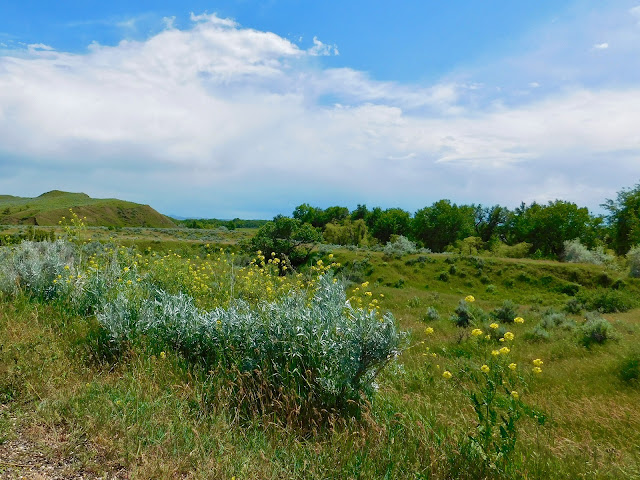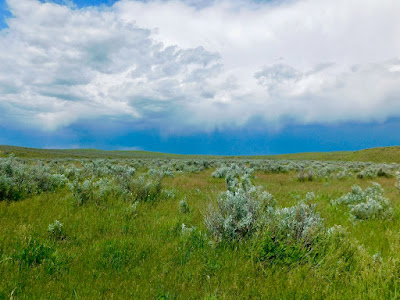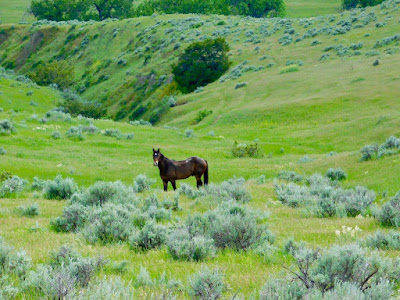Little Bighorn Battlefield - Part II
 |
| Medicine Tail Coulee Ford |
What happened to General Custer after he separated from Major Reno is one of the great mysteries of the American West. Because there were no survivors from Custer's battalion, the truth will forever elude historians, fanning the flames of controversy that are sparked by the multitude of differing theories.
A wealth of information can be gathered from Native American oral history as circulated by the battle's victorious participants, documents containing eyewitness testimony from soldiers who surveyed the battlefield's aftermath and recent archaeological discoveries.
By combining the evidence from these three sources, we can get a pretty good feel for what happened concerning Custer's strategy, movement and ultimate demise. The following is how I believe the events of that fateful day may have transpired.
While Reno and his men were being chased back to high ground, Custer was dividing his battalion into two wings. Companies C, I and L stayed in the hills to the right while E and F began an offensive maneuver to the left.
Mounted on their magnificent gray horses, Company E led the left wing down a dry creek bed. Appearing like apparitions out of the mist, they attempted to cross the river at the mouth of Medicine Tail Coulee.
Being a gateway to the Indian's camp, the ford was defended fiercely by a small band of brave warriors. Using repeating rifles, the Indians rained bullets at the incoming threat, forcing the white soldiers to ascend back into the eastern bluffs.
The left wing reunited briefly with the right wing atop Calhoun Hill. With Companies I and C held in reserve, Company L deployed in a skirmish line and the engagement continued with light, long-range volleys exchanged between the two sides.
Custer, still on the offensive, descended from the smooth ridge and tried to ford the river north of the encampment but he was stopped again. As they returned, Company E spread out across a shallow ravine and fired at hostiles creeping up the western flats while Company F gravitated into the basin above.
Most of the Indians that had fought Reno arrived on the scene as the hills became saturated with angry warriors hidden in the gullies and ravines. After Lame White Man's aggressive charge from Greasy Grass Ridge, the clash escalated quickly.
Chiefs Gall and Crazy Horse took advantage of the ensuing chaos and led their followers as they decimated the troops retreating from Calhoun Hill. Most of the horses were killed or scattered so the soldiers fell back on foot across Battle Ridge in an attempt to link up with Custer and the left wing.
Finishing off the frightened, fleeing soldiers was easy pickings for the Indians because it was just like hunting buffalo on the run. Many of the inexperienced, young soldiers became panicked so all tactical cohesion was lost and the rout was on.
Meanwhile at the other end of Battle Ridge, Company E's line was destroyed by the 'Suicide Boys' who also stampeded the conspicuous gray horses. Custer's Headquarters Staff moved up the slope where they were joined by a few surviving refugees from the right wing.
Just below the summit of Custer Hill, about 40 soldiers from the Seventh Cavalry put down their mounts forming a horse-flesh barricade and made their desperate last stand. The men were completely surrounded as arrows sprayed into the center of their precarious position.
Eventually as the soldiers began to fall, the Indians initiated hand-to-hand combat and the tiny swatch of blue coats was completely overwhelmed. At the end, about 15 men tried to make a run for cover by sprinting towards the river but none of them escaped.
Once the last of the troopers were cut down, the process of ritualistic mutilation began. Most of the dead were stripped naked and their bodies mutilated because the Indians believed if they crippled the soldiers' bodies on earth, the soldiers wouldn't be able to harm them in the afterlife.
After they had defeated Custer, the warriors turned their attention back towards the secluded hilltop held by Reno and the recently arrived Captain Benteen. With seven companies dug in and holding the high ground, the soldiers prepared to ward off an impending attack.
 |
| What happened to Custer is a mystery |
 |
| Custer was in the hills during Reno's charge |
 |
| Custer tried to ford the river here |
 |
| A gateway to the Indian camp |
 |
| Troops ascended this coulee to Calhoun Hill |
 |
| Warriors crept up these gullies and ravines |
 |
| Most of the horses were stampeded or killed |
 |
| At the end, soldiers dashed for this ravine |
 |
| Reno's troops dug into this secluded hilltop |